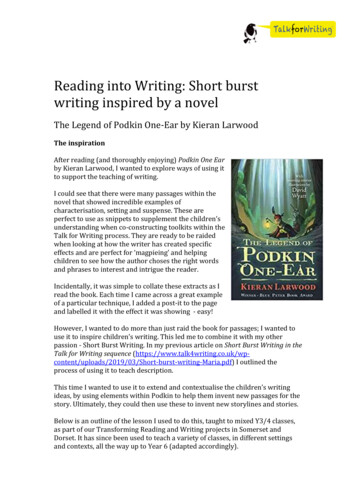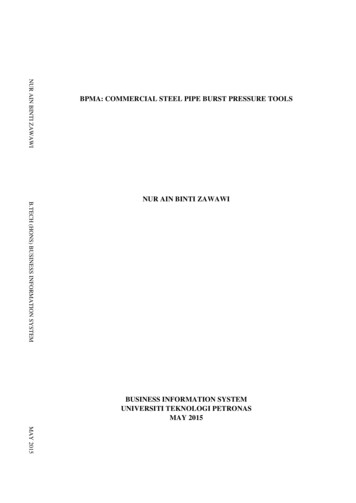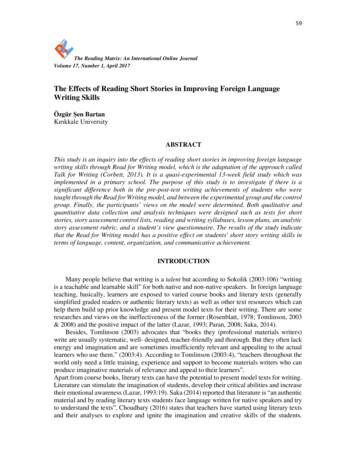
Transcription
Reading into Writing: Short burstwriting inspired by a novelThe Legend of Podkin One-Ear by Kieran LarwoodThe inspirationAfter reading (and thoroughly enjoying) Podkin One Earby Kieran Larwood, I wanted to explore ways of using itto support the teaching of writing.I could see that there were many passages within thenovel that showed incredible examples ofcharacterisation, setting and suspense. These areperfect to use as snippets to supplement the children’sunderstanding when co-constructing toolkits within theTalk for Writing process. They are ready to be raidedwhen looking at how the writer has created specificeffects and are perfect for ‘magpieing’ and helpingchildren to see how the author choses the right wordsand phrases to interest and intrigue the reader.Incidentally, it was simple to collate these extracts as Iread the book. Each time I came across a great exampleof a particular technique, I added a post-it to the pageand labelled it with the effect it was showing - easy!However, I wanted to do more than just raid the book for passages; I wanted touse it to inspire children’s writing. This led me to combine it with my otherpassion - Short Burst Writing. In my previous article on Short Burst Writing in theTalk for Writing sequence 2019/03/Short-burst-writing-Maria.pdf) I outlined theprocess of using it to teach description.This time I wanted to use it to extend and contextualise the children’s writingideas, by using elements within Podkin to help them invent new passages for thestory. Ultimately, they could then use these to invent new storylines and stories.Below is an outline of the lesson I used to do this, taught to mixed Y3/4 classes,as part of our Transforming Reading and Writing projects in Somerset andDorset. It has since been used to teach a variety of classes, in different settingsand contexts, all the way up to Year 6 (adapted accordingly).
The LessonAs a warm up, I showed the children the image below and asked them what theythought it could be, for example: an ancient fan used for keeping a grumpy giantcool. This was to get the children thinking creatively and going beyond theobvious.I then explained that I wanted us to use our imagination to write a description ofa new character for the novel I was reading. I introduced them to Podkin, readthem the blurb and gave them a brief synopsis of the storyline. I got them toclose their eyes whilst I read them the passage below, to set the scene for ourwriting. I explained that the main characters where on a quest to find help andrefuge and ended up in this setting and this was where our new animal characterwas going to appear. (Pg 111 of the novel & I stopped at ‘thirsty for blood.’)
My first question to the children was: What kind of atmosphere does this create?Replies included scary, sinister,evil, dark, mysterious, spooky. Iexplained that Podkin was goingto meet a new animal characterhere and the way we described itneeded to fit with theatmosphere. It was then that Ishowed the children the newcharacter we were going to writeinto the story, using this visual:We looked separately at each aspect that we wanted to focus on and generatedvocabulary (adjectives & verbs) to describe it.Taking each element in turn, as the spine to ourdescription, we crafted the writing together; me leadingthe discussions on what worked best, referring children tothe vocabulary gathered and constantly considering thebest descriptions with fresh, new ideas. Here is an exampleof what we created:The OwlThe stern owl glares,Monstrous, oval eyes pierce in the ruby twilight,Hook beak tears like a poisonous dagger,Midnight-tipped feathers, like dragon’s scales, slitheracross its body,Scythe talons rip and snatch,Like a dark knight, a lord of the kingdom, a demon soldier,it guards.
Now it was time to put our character back into the story. After the settingdescription on Pg111 of Podkin, the characters push on with their journey,eventually finding the place they have been searching for. I read the children thisextract from Pg 118 and explained we were going to drop our new character intothis scene:I gave them a linking sentence start: Then Podkin saw it and showed thechildren how to drop our creative description in to narrative, keeping the moodand atmosphere the same. This was the result:And then Podkin saw it. A sternlooking owl was glaring at thesiblings. His monstrous, oval eyespierced the ruby twilight and Podkincould just make out its hook-beak, likea poisonous dagger, ready to tearthem to shreds. Midnight-tippedfeathers slithered across his entirebody, like menacing dragon scales.Nervously, Paz took a step back at thesight of the creature’s scythe talons,ripping at the ice and ready to snatchany intruder attempting to storm theentrance of the tunnel. Just like a darkdemon, it guarded Boneroot.
What next?Over a series of lessons, the children could then use this method to createalternate animal characters to drop into this scene. They could also add to otherparts of the story where action or interaction takes place, either extending thestoryline or dropping in scenes. They could practice extending the description ofsettings or adding in suspense at various parts of the novel and they could alsotake the new animal characters created and use them when writing a sequel orprequel to a ‘Podkin-like’ story. This could be done in the same Journey storystructure or any that fitted their composition, like a Tale of Fear or a WarningStory.Overall, using the novel as the main stimulus for practising writing skills andultimately using it as a springboard for new, invented writing was extremelysuccessful. It also sparked so many other ideas on how to use snippets fromnovels to practice or inspire writing. Watch this space for more novel-inspiredlessons in the future!Maria RichardsTalk for Writing Primary ExpertMaria Richards is available to deliver Talk for Writingtraining throughout the UK & internationally. Please visitthe training page on the Talk for Writing website for moredetails. Want a project to run in your area? Contact Mariafor details.
Reading into Writing: Short burst writing inspired by a novel The Legend of Podkin One-Ear by Kieran Larwood The inspiration After reading (and thoroughly enjoying) Podkin One Ear by Kieran Larwood, I wanted to explore ways of using it to support the teaching of writing










